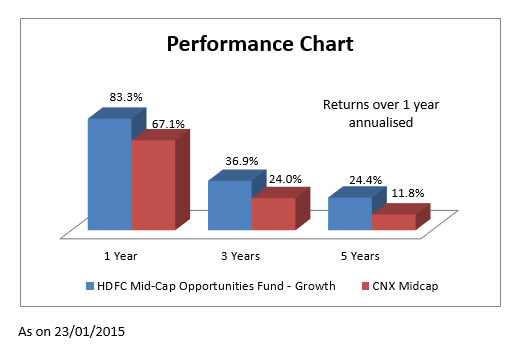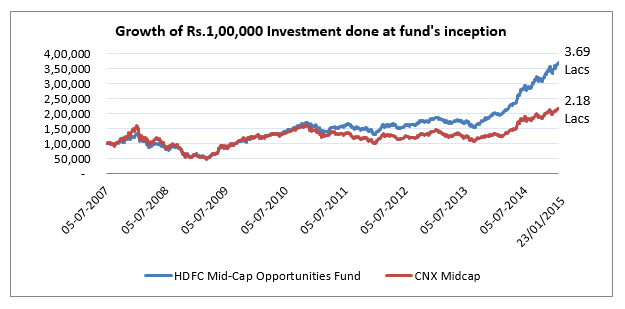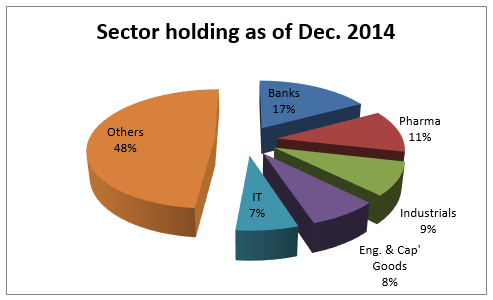If you are looking for mid-cap exposure but with limited volatility, you can consider phased investments in units of HDFC Mid-Cap Opportunities. The fund takes adequate exposure to companies in the mid-cap space and has exposure to sectors that could sail fast in an upturn. Some of the mid and small companies that were hit by the downturn, but still managed to keep themselves well afloat in tough years, may be amongst the best placed to use a recovery to capture the fortunes.
With a return of 24 per cent compounded annually in the last five years, the fund’s performance is a good 12 percentage points higher than its benchmark, CNX Midcap, and 5 percentage points higher than the mid-cap fund category’s average returns.
The fund completed seven years in mid-2014 and has now seen a full market cycle. Its ability to contain downsides and provide superior risk-adjusted returns makes it a good candidate for investors who are not too adventurous.
Suitability
HDFC Mid-Cap Opportunities can be labelled as a less risky fund among the universe of mid-cap schemes. This is because its exposure to small or micro-cap stocks is not as high as certain other peers.
That said, the fund still remains riskier than regular diversified equity schemes, and will fit only a long-term wealth-building portfolio. You can consider investing in it through the Systematic Investment Plan (SIP) option spread over not less than three years. Avoid stopping SIPs in a down market because that is the time you can average your cost. Review your SIPs only when the fund underperforms peers for a period of six months to a year.
Performance
HDFC Mid-Cap Opportunities beat its benchmark, CNX Midcap, 94 per cent of the times, on a one-year rolling return basis in the last five years. That is an above-average performance, considering this mid-cap index is a tough benchmark to beat.
The fund has generated about 31 per cent SIP returns in the last five years, which is 13 percentage points higher than its CNX midcap index. Point-to-point returns of the fund is 24 per cent annualised in the last five years, which is 12 percentage points higher than its CNX midcap index.
The fund has the ability to generate consistent returns even in choppy markets as was seen in 2011 and 2013. These qualities were displayed to best effect in 2011. When the index fell by 31 per cent, this fund contained losses to 18.3 per cent. In 2013, the fund rose by 9.6 per cent, while its benchmark was in the red.
Portfolio
HDFC Mid-Cap Opportunities was a closed-end fund until mid 2010. Therefore, it was easier for the fund to combat the market meltdown in 2008 and bounce back in 2009, as it comfortably stayed almost fully invested in equities. But even after it became open-ended, the fund continued to stay over 90-percent invested in equities, irrespective of market volatility. This feature is true of most other funds from the HDFC stable.
It has also stayed cautious on volatile small caps. This fund is growth oriented and focuses on identifying companies that can grow at higher-than-industry rates. Size, however, has forced this fund to own a rather large number of stocks (67 as on December end) with small weights in each. The top ten stocks accounts for just 24 per cent of the portfolio.
HDFC Mid-Cap Opportunities currently sports an interesting portfolio with high exposure to banks, pharma and interestingly, industrial products. The top two picks in the portfolio are in pharma stocks – Aurobindo Pharma and Torrent Pharma – accounting for 5.5 per cent of the portfolio. Overall allocation in the pharma sector was 11.5 per cent.
The fund holds around 6.6 per cent of the portfolio in PSU banks such as Bank of Baroda, Union bank of India and Allahabad bank. It also holds private sector banks such as Axis bank, Federal Bank and ING Vysya Bank.
The fund is managed by Chirag Setalvad since inception.
*Mutual Fund investments are subject to market risks, read all scheme related documents carefully. Past performance is not indicative of future results. To know how to read our weekly fund reviews, please click here.










I have issue with representation of returns – CAGR is easy, but more focused analysis on downturn market should be done. And, how is the portfolio positioned for performance in the next 3-5 years? Futuristic tendencies of the fund management also must be addressed. Those are not clear.
Thanks for the suggestion.Investment growth of Rs 1 Lakh, given in the accompanied graph,highlights how the fund has performed compared to its index. In our future analysis, We will try to add the best and worst performance of the fund since inception. It is difficult to predict future performance of fund manager. What we do is look at the portfolio, sector and stock exposure and understand the potential. These factors are considered to choose the fund.
Hi Bharani! Please go through the analyst rating of Morningstar India. You will get an idea of future prospects of funds.
Hi Kuntal, Thanks, I do see VRO, morningstar and other sources, but was pointing out what uniqueness fundsindia can bring in the analysis.
Hello Bharani, You will appreciate that the ratings of VRO are first quite short term in nature (going by how frequently the star ratings change) and hardly factor in qualitative metrics..which is why any inherent risk in a portfolio – either in debt or equity will not be fully factored in. FundsIndia’s select funds take into account quantitative metrics (sharpe, Std. dev, rolling return beta etc) as well as quality of portfolio, to highlight investment-worthy options. A fully automated analysis tool cannot do this. You will see it in the quality of calls we give, if you start using our platform. Besides the tools available (including portfolio level x-ray for which we use morningstar) is not something you can get for free with the others. thanks, Vidya
Hello Sir,
Thanks. My points were these: 1. I can take the comparative stats from VRO or morningstar, but was talkeing about analysis – eg: if it suffered only 9% in a 18% downturn, what were the fundental reasons; instead of generic comments like quality stocks, better fund management etc, better to state why and how it happened, and if it has a good chance of repeating in the future!
2. Prognosis should be based on track record and tendencies, based on what mgt did! Of course we can’t predict what fund mgr will do, but we can use logical reasoning!
I hope I make sense! Forgive me if I ain’t!
Bharani, we do factor in why a fund fell when it fell and why it did well when it did. This is the basis of any analysis (beyond the usual quantitative metrics) when we look into a fund. We do put in few lines in some of our calls (if you have been following us for long) and not in others where we want to keep the word count in check. You will appreciate explaining all that would require a 5-page essay:-) I am not sure if many of our investors want to go beyond a 500 word analysis. Our idea is to factor in as much info as possible as give the recommendation. thanks.
Great replies Vidya, thanks. No, I haven’t followed fundsindia for long (< 1 yr), but had good words thru hearsay! So trying to help with critical comments! I read multiple blogs (not competent enough to start my own!), but not a lot of quality articles are out there for MFs.
Totally agree being laconic in the analysis, but still feel articulation can focus on some instances where a decision made by fund/stock shielded it from impending downturn or propped up the gains in upturn. Also, whether it was due to fund manager's decision or it was due to institutionalized process in the management team.
As an individual investor, I would be looking for these facts, so I can ascertain if these scenarios are repeatable in future.
Hi,
I have been investing in this fund from 4+ years and the returns are fantastic.
Is it advisable to book some profits and invest in debt fund?
My goals are still 12+ years ahead.
Hi Jai, given your time frame, unless you need to rebalance your asset allocation if you have one (say your original equity allocation has gone up from say 60% to 70% and debt from 40% to 30% and so on), there may not be much need to book profits. regards, Vidya
Thank u Vidya for clarification, there is an overall 9% increase in equity allocation and of it 5% contribution was from this fund. So had a thought of booking some profits as it was a mid-cap fund.
Hi,
I have been investing in this fund from 4+ years and the returns are fantastic.
Is it advisable to book some profits and invest in debt fund?
My goals are still 12+ years ahead.
Hi Jai, given your time frame, unless you need to rebalance your asset allocation if you have one (say your original equity allocation has gone up from say 60% to 70% and debt from 40% to 30% and so on), there may not be much need to book profits. regards, Vidya
Thank u Vidya for clarification, there is an overall 9% increase in equity allocation and of it 5% contribution was from this fund. So had a thought of booking some profits as it was a mid-cap fund.
I have issue with representation of returns – CAGR is easy, but more focused analysis on downturn market should be done. And, how is the portfolio positioned for performance in the next 3-5 years? Futuristic tendencies of the fund management also must be addressed. Those are not clear.
Thanks for the suggestion.Investment growth of Rs 1 Lakh, given in the accompanied graph,highlights how the fund has performed compared to its index. In our future analysis, We will try to add the best and worst performance of the fund since inception. It is difficult to predict future performance of fund manager. What we do is look at the portfolio, sector and stock exposure and understand the potential. These factors are considered to choose the fund.
Hello Sir,
Thanks. My points were these: 1. I can take the comparative stats from VRO or morningstar, but was talkeing about analysis – eg: if it suffered only 9% in a 18% downturn, what were the fundental reasons; instead of generic comments like quality stocks, better fund management etc, better to state why and how it happened, and if it has a good chance of repeating in the future!
2. Prognosis should be based on track record and tendencies, based on what mgt did! Of course we can’t predict what fund mgr will do, but we can use logical reasoning!
I hope I make sense! Forgive me if I ain’t!
Bharani, we do factor in why a fund fell when it fell and why it did well when it did. This is the basis of any analysis (beyond the usual quantitative metrics) when we look into a fund. We do put in few lines in some of our calls (if you have been following us for long) and not in others where we want to keep the word count in check. You will appreciate explaining all that would require a 5-page essay:-) I am not sure if many of our investors want to go beyond a 500 word analysis. Our idea is to factor in as much info as possible as give the recommendation. thanks.
Great replies Vidya, thanks. No, I haven’t followed fundsindia for long (< 1 yr), but had good words thru hearsay! So trying to help with critical comments! I read multiple blogs (not competent enough to start my own!), but not a lot of quality articles are out there for MFs.
Totally agree being laconic in the analysis, but still feel articulation can focus on some instances where a decision made by fund/stock shielded it from impending downturn or propped up the gains in upturn. Also, whether it was due to fund manager's decision or it was due to institutionalized process in the management team.
As an individual investor, I would be looking for these facts, so I can ascertain if these scenarios are repeatable in future.
Hi Bharani! Please go through the analyst rating of Morningstar India. You will get an idea of future prospects of funds.
Hi Kuntal, Thanks, I do see VRO, morningstar and other sources, but was pointing out what uniqueness fundsindia can bring in the analysis.
Hello Bharani, You will appreciate that the ratings of VRO are first quite short term in nature (going by how frequently the star ratings change) and hardly factor in qualitative metrics..which is why any inherent risk in a portfolio – either in debt or equity will not be fully factored in. FundsIndia’s select funds take into account quantitative metrics (sharpe, Std. dev, rolling return beta etc) as well as quality of portfolio, to highlight investment-worthy options. A fully automated analysis tool cannot do this. You will see it in the quality of calls we give, if you start using our platform. Besides the tools available (including portfolio level x-ray for which we use morningstar) is not something you can get for free with the others. thanks, Vidya